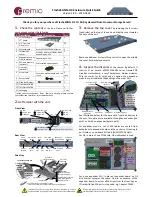
Rev. 1.10
104
November 26, 2019
Rev. 1.10
105
November 26, 2019
HT68FB240
USB Low Speed Flash MCU
USB Endpoint 0 OUT Token Interrupt
A USB Endpoint 0 OUT Token interrupt request will take place when the USB Endpoint 0 OUT
Token interrupt request flags, U
OT
F, is set, a situation that will occur when the USB receives
endpoint 0 OUT
token signal from PC. To allow the program to branch to its respective interrupt
vector address, the global interrupt enable bit, EMI, and USB Endpoint 0 OUT Token interrupt
enable bit, U
OT
E, must first be set. When the interrupt is enabled, the stack is not full and an
endpoint is accessed, a subroutine call to the USB Endpoint 0 OUT Token interrupt vector, will take
place. When the interrupt is serviced, the USB Endpoint 0 OUT Token interrupt request flag, U
OT
F,
will be automatically reset and the EMI bit will be automatically cleared to disable other interrupts.
Serial Interface Module Interrupt
The Serial Interface Module interrupt, known as the SIM interrupt, will take place when the
SIM Interrupt request flag, SIMF, is set, which occurs when a byte of data has been received or
transmitted by the SIM interface. To allow the program to branch to its respective interrupt vector
address, the global interrupt enable bit, EMI, and the Serial Interface Interrupt enable bit, SIME,
must first be set. When the interrupt is enabled, the stack is not full and a byte of data has been
transmitted or received by the SIM interface, a subroutine call to the respective Interrupt vector, will
take place. When the Serial Interface Interrupt is serviced, the EMI bit will be automatically cleared
to disable other interrupts and the SIMF flag will be automatically cleared as well.
LVD Interrupt
The Low Voltage Detector interrupt, known as the LVD interrupt, will take place when the LVD
Interrupt request flag, LVF, is set, which occurs when the Low Voltage Detector function detects a
low power supply voltage. To allow the program to branch to its respective interrupt vector address,
the global interrupt enable bit, EMI and Low Voltage Interrupt enable bit, LVE, must first be set.
When the interrupt is enabled, the stack is not full and a low voltage condition occurs, a subroutine
call to the LVD Interrupt vector, will take place. When the Low Voltage Interrupt is serviced,
the EMI bit will be automatically cleared to disable other interrupts and the LVF flag will be
automatically cleared as well.
Multi-function Interrupt
Unlike the other independent interrupts, these interrupts have no independent source, but rather are
formed from other existing interrupt sources, namely the TM Interrupts.
A Multi-function interrupt request will take place the Multi-function interrupt request flag, MF
0F
is set. The Multi-function interrupt flag will be set when any of its included functions generate an
interrupt request flag. To allow the program to branch to its respective interrupt vector address,
when the Multi-function interrupt is enabled and the stack is not full, and either one of the interrupts
contained within each of Multi-function interrupt occurs, a subroutine call to the Multi-function
interrupt vector will take place. When the interrupt is serviced, the related Multi-Function request
flag will be automatically reset and the EMI bit will be automatically cleared to disable other
interrupts.
However, it must be noted that, although the Multi-function Interrupt flags will be automatically
reset when the interrupt is serviced, the request flags from the original source of the Multi-function
interrupts, namely the TM Interrupts, will not be automatically reset and must be manually reset by
the application program.
















































